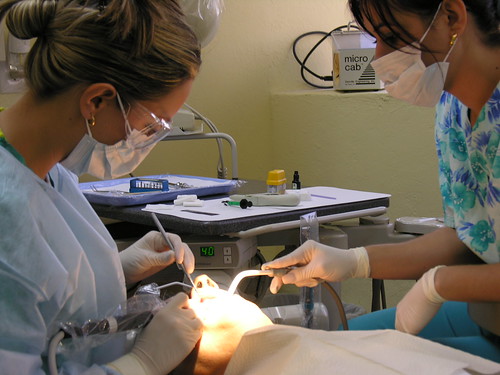 The drill has long been a dreaded association with dentists and one of the very reasons why many people fear making their dental appointments. Traditionally, dentists used drills to administer to conditions of tooth decay and other procedures, but modern advances in science have made it so that dentists don’t always have to necessarily turn to the drill. An innovative alternative known as air abrasion is a drill-less technique that more and more dentists are employing in their practices.
The drill has long been a dreaded association with dentists and one of the very reasons why many people fear making their dental appointments. Traditionally, dentists used drills to administer to conditions of tooth decay and other procedures, but modern advances in science have made it so that dentists don’t always have to necessarily turn to the drill. An innovative alternative known as air abrasion is a drill-less technique that more and more dentists are employing in their practices.
What is Air Abrasion?
Air abrasion utilizes air rather than a drill to blast away tooth decay. The machine used in the process operates much like a mini sandblaster or air compression machine, aiming a fine stream of particles at the tooth to remove the decayed or stained portion. The stream of particles is made up of aluminum oxide, silica and baking soda, and as it hits the particles on the tooth that needs to be removed, it removes them. As the particles are blasted from the tooth via the air stream, they are sucked away with a dental suction tube.
Types of Procedures Performed with Air Abrasion
In addition to blasting away stains and other particles that show the signs of tooth decay, air abrasion can also be used to remove some old composite restorations. However, they cannot be used to for metallic restorations such as with silver amalgam fillings. Additionally, air abrasion is effective at preparing teeth for sealants or bonding, such as the type that is used before affixing traditional braces to teeth.
Pros of Air Abrasions
 Perhaps one of the most notable benefits of air abrasions is that they are virtually painless. Because of this, they very rarely require any type of anesthesia. Additionally, there aren’t any vibrations or heat generated by the air abrasion machine, so patients don’t have to worry about the soft tissue in their mouths getting harmed. Additionally, air abrasion techniques tend to be more precise than drilling ones, so they remove less of the natural tooth than drilling does. Air abrasion also makes it so that dentists can sometimes spot shallow cavities and fill them in the same day.
Perhaps one of the most notable benefits of air abrasions is that they are virtually painless. Because of this, they very rarely require any type of anesthesia. Additionally, there aren’t any vibrations or heat generated by the air abrasion machine, so patients don’t have to worry about the soft tissue in their mouths getting harmed. Additionally, air abrasion techniques tend to be more precise than drilling ones, so they remove less of the natural tooth than drilling does. Air abrasion also makes it so that dentists can sometimes spot shallow cavities and fill them in the same day.
Ideal Candidates for Air Abrasion
Children and others who fear the pain or process of dental drilling in general are typically ideal candidates for air abrasion. However, people who have deep cavities that need to be addressed would be better off just going ahead with a drilling procedure since it will most likely have to be used in the long run anyways. The time it takes air abrasion techniques to reach deeper cavities is much longer than that of traditional drilling. Additionally, crowns, inlays and onlays can’t be prepared via air abrasion techniques; they require more intense techniques. Moreover, if any enamel needs to be removed from the tooth, then air abrasion won’t be sufficient to gain access. Once the enamel is drilling through, though, air abrasion may be used.
References:
Hegde, Vivek S and Khatavkar, Roheet A. ” A new dimension to conservative dentistry: Air abrasion.” Retrieved on October 2p, 2015, from http://www.ncbi.nlm.nih.gov/pmc/articles/PMC2883800/ .
The United States National Library of Medicine National Institutes of Health
8600 Rockville Pike,
Bethesda MD, 20894 USA
1-888-FIND-NLM
http://www.ncbi.nlm.nih.gov
Images:
https://farm4.staticflickr.com/3164/2634324252_e994d96416.jpg
https://farm4.staticflickr.com/3014/2825172225_4c742f7600.jpg